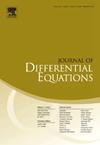On uniqueness of KP soliton structures
IF 2.4
2区 数学
Q1 MATHEMATICS
引用次数: 0
Abstract
We consider the Kadomtsev-Petviashvili II (KP) model placed in , in the case of smooth data that are not necessarily in a Sobolev space. In this paper, the subclass of smooth solutions we study is of “soliton type”, characterized by a phase and a unidimensional profile F. In particular, every classical KP soliton and multi-soliton falls into this category with suitable Θ and F. We establish concrete characterizations of KP solitons by means of a natural set of nonlinear differential equations and inclusions of functionals of Wronskian, Airy and Heat types, among others. These functional equations only depend on the new variables Θ and F. A distinct characteristic of this set of functionals is its special and rigid structure tailored to the considered soliton. By analyzing Θ and F, we establish the uniqueness of line-solitons, multi-solitons, and other degenerate solutions among a large class of KP solutions. Our results are also valid for other 2D dispersive models such as the quadratic and cubic Zakharov-Kuznetsov equations.
关于KP孤子结构的唯一性
在平滑数据不一定在Sobolev空间的情况下,我们考虑放置在Rt×Rx,y2中的Kadomtsev-Petviashvili II (KP)模型。本文研究的光滑解的子类是“孤子型”,其特征为相位Θ=Θ(t,x,y)和一维轮廓F.特别是,每一个经典KP孤子和多孤子都属于这一类,具有合适的Θ和F.我们利用一组自然的非线性微分方程和Wronskian型、Airy型和Heat型泛函的包含建立了KP孤子的具体表征。这些泛函方程只依赖于新的变量Θ和f。这组泛函的一个显著特征是它为所考虑的孤子量身定制的特殊和刚性结构。通过对Θ和F的分析,我们在一大类KP解中建立了线孤子、多孤子和其他退化解的唯一性。我们的结果也适用于其他二维色散模型,如二次和三次Zakharov-Kuznetsov方程。
本文章由计算机程序翻译,如有差异,请以英文原文为准。
求助全文
约1分钟内获得全文
求助全文
来源期刊
CiteScore
4.40
自引率
8.30%
发文量
543
审稿时长
9 months
期刊介绍:
The Journal of Differential Equations is concerned with the theory and the application of differential equations. The articles published are addressed not only to mathematicians but also to those engineers, physicists, and other scientists for whom differential equations are valuable research tools.
Research Areas Include:
• Mathematical control theory
• Ordinary differential equations
• Partial differential equations
• Stochastic differential equations
• Topological dynamics
• Related topics

 求助内容:
求助内容: 应助结果提醒方式:
应助结果提醒方式:


